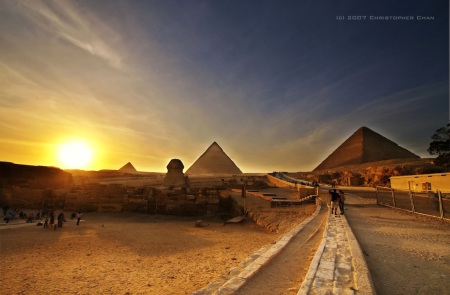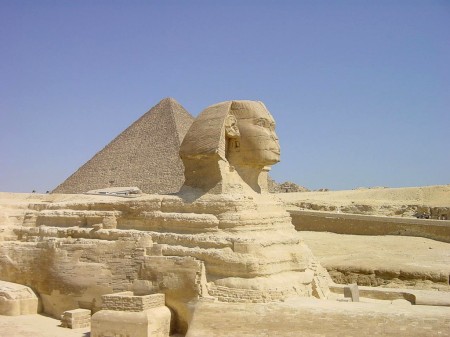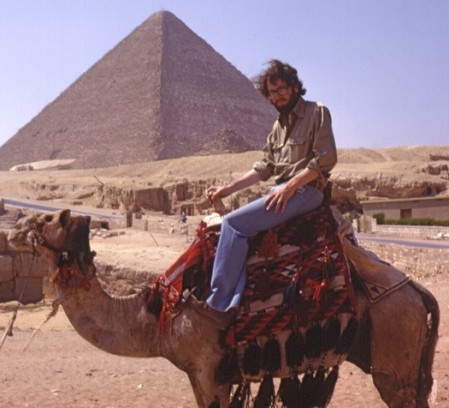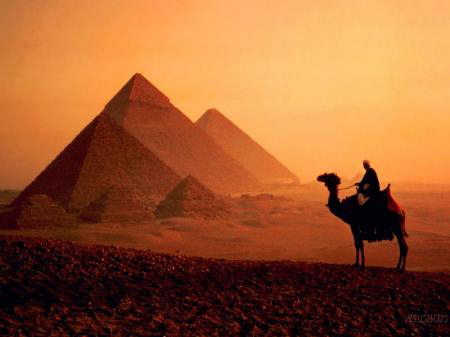Giza is home to one of the most
awe enspiring landmarks in the world, the ‘Great Pyramid’. The last
remaining of the seven wonders of the world, the great pyramid and other
pyramids of Giza are a must see for tourists in Egypt. Aside from the
pyramids, Giza also is home to the ‘Great Sphinx’, whilst looking it’s
age at 6000 years old, it is still another of Giza’s fantastic tourist
attractions and is only a short walk away from the pyramids.
Contrary to the common belief, only the
Great Pyramid of Khufu (Cheops), not all three Great Pyramids, is on
top of the list of Wonders. The monument was built by the Egyptian
pharaoh Khufu of the Fourth Dynasty around the year 2560 BC to serve as a
tomb when he dies.
The tradition of pyramid building
started in Ancient Egypt as a sophistication of the idea of a mastaba or
“platform” covering the royal tomb. Later, several stacked mastabas
were used. Early pyramids, such as the Step Pyramid of King Zoser
(Djoser) at Saqqara by the famous Egyptian architect, Imhotep,
illustrate this connection.
The great pyramid is believed to have
been built over a 20 year period. The site was first prepared, and
blocks of stone were transported and placed. An outer casing (which
disappeared over the years) was then used to smooth the surface.
Although it is not known how the blocks were put in place, several
theories have been proposed.
One theory involves the construction
of a straight or spiral ramp that was raised as the construction
proceeded. This ramp, coated with mud and water, eased the displacement
of the blocks which were pushed (or pulled) into place. A second theory
suggests that the blocks were placed using long levers with a short
angled foot.
The Pyramid of Khafre (Chephren)
– slightly smaller than the Great Pyramid, though appearing from some
angles to appear larger owing to a better position on the desert plateau
The Pyramid of Menkaure (Mycerinus) – the smallest of the Giza Pyramids at 62 m (203 ft) high (originally 66.5 m)
The Sphinx and the Temple of the Sphinx – the colossal, recumbent human-headed lion was conceived of by the ancient Egyptians as the sun god Re-Horakhty – “Horus of the horizon”. The Egyptians call it Abu el-Hol , the “Father of Terror”, and even the Greek name Sphinx is the less than pleasant “Strangler”. 45 meters long, 22 meters wide, and carved from a single giant block of sandstone, the Sphinx is considerably smaller than the Pyramids around it. The missing nose is blamed on target practice by bored troops, commonly blamed variously on British soldiers in World War I or Napoleon’s troops in 1798, but 18th-century drawings showing the nose already missing, pointing the finger towards the occupying Turks.
The Sphinx and the Temple of the Sphinx – the colossal, recumbent human-headed lion was conceived of by the ancient Egyptians as the sun god Re-Horakhty – “Horus of the horizon”. The Egyptians call it Abu el-Hol , the “Father of Terror”, and even the Greek name Sphinx is the less than pleasant “Strangler”. 45 meters long, 22 meters wide, and carved from a single giant block of sandstone, the Sphinx is considerably smaller than the Pyramids around it. The missing nose is blamed on target practice by bored troops, commonly blamed variously on British soldiers in World War I or Napoleon’s troops in 1798, but 18th-century drawings showing the nose already missing, pointing the finger towards the occupying Turks.
Various Queens’ Pyramids and Nobles’ Tombs , located in regimented cemeteries surrounding the royal pyramids.
Consider attending the nightly Sound and Light Show ( Son-et-Lumière ) – a bit kitsch, but a worthwhile evening activity.
Avoid succumbing to the temptation of taking a camel ride around the Pyramids – not only is it a bit naff, but the practice is noisy, smelly and overrated – the camel drivers are also frequent targets for accusations of harrassment and petty crime. Most also do one way trips (without telling you) on a camel, after leaving you half a mile into the desert, you’re either expected to either walk back or book a return journey.
Avoid succumbing to the temptation of taking a camel ride around the Pyramids – not only is it a bit naff, but the practice is noisy, smelly and overrated – the camel drivers are also frequent targets for accusations of harrassment and petty crime. Most also do one way trips (without telling you) on a camel, after leaving you half a mile into the desert, you’re either expected to either walk back or book a return journey.









0 comments:
Đăng nhận xét